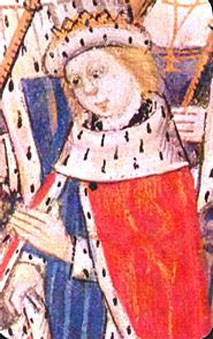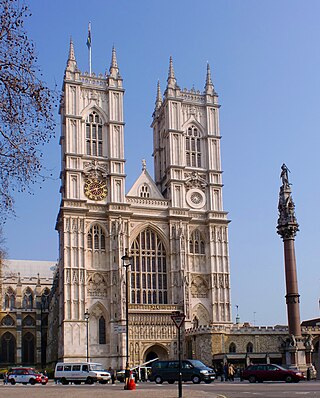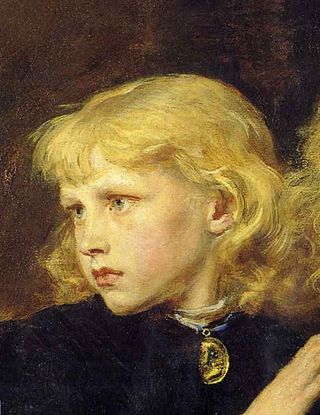Related Research Articles

Edward V was King of England from 9 April to 25 June 1483. He succeeded his father, Edward IV, upon the latter's death. Edward V was never crowned, and his brief reign was dominated by the influence of his uncle and Lord Protector, the Duke of Gloucester, who deposed him to reign as King Richard III; this was confirmed by the Act entitled Titulus Regius, which denounced any further claims through his father's heirs.

Westminster Abbey, formally titled the Collegiate Church of Saint Peter at Westminster, is an Anglican church in the City of Westminster, London, England. Since 1066, it has been the location of the coronations of 40 English and British monarchs, and a burial site for 18 English, Scottish, and British monarchs. At least 16 royal weddings have taken place at the abbey since 1100.

The Abbey Church of Saint Peter and Saint Paul, commonly known as Bath Abbey, is a parish church of the Church of England and former Benedictine monastery in Bath, Somerset, England. Founded in the 7th century, it was reorganised in the 10th century and rebuilt in the 12th and 16th centuries; major restoration work was carried out by Sir George Gilbert Scott in the 1860s. It is one of the largest examples of Perpendicular Gothic architecture in the West Country. The medieval abbey church served as a sometime cathedral of a bishop. After long contention between churchmen in Bath and Wells the seat of the Diocese of Bath and Wells was later consolidated at Wells Cathedral. The Benedictine community was dissolved in 1539 during the Dissolution of the Monasteries.

Anne de Mowbray, 8th Countess of Norfolk, later Duchess of York and Duchess of Norfolk was the child bride of Richard of Shrewsbury, Duke of York, one of the Princes in the Tower. She died at the age of eight.

George Vertue was an English engraver and antiquary, whose notebooks on British art of the first half of the 18th century are a valuable source for the period.

Richard of Shrewsbury, Duke of York, was the sixth child and second son of King Edward IV of England and Elizabeth Woodville, born in Shrewsbury. Richard and his older brother, who briefly reigned as King Edward V of England, mysteriously disappeared shortly after their uncle Richard III became king in 1483.

The Most Honourable Order of the Bath is a British order of chivalry founded by King George I on 18 May 1725. The name derives from the elaborate medieval ceremony for appointing a knight, of which bathing was an element. Knights so created were known as 'Knights of the Bath'. George I constituted the Knights of the Bath a regular 'Military Order'. He did not revive the Order of the Bath, which had not previously existed as an Order, in the sense of a body of knights governed by a set of statutes and whose numbers were replenished when vacancies occurred.

The Henry VII Lady Chapel, now more often known just as the Henry VII Chapel, is a large Lady chapel at the far eastern end of Westminster Abbey, England, paid for by the will of King Henry VII. It is separated from the rest of the abbey by brass gates and a flight of stairs.

A fan vault is a form of vault used in the Gothic style, in which the ribs are all of the same curve and spaced equidistantly, in a manner resembling a fan. The initiation and propagation of this design element is strongly associated with England.

The Chapel Royal of St Peter ad Vincula is a Chapel Royal and the former parish church of the Tower of London. The chapel's name refers to the story of Saint Peter's imprisonment under Herod Agrippa in Jerusalem. Situated within the Tower's Inner Ward, its current building dates from 1520, although the church was likely established in the 12th century. The church for working residents was the second chapel established in the Tower after St John's, a smaller royal chapel built into the 11th century White Tower. A royal peculiar, under the jurisdiction of the monarch, the priest responsible for these chapels is the chaplain of the Tower, a canon and member of the Ecclesiastical Household. The canonry was abolished in 1685 but reinstated in 2012.
Henry Yevele (c. 1320 – 1400) was the most prolific and successful master mason active in late medieval England. The first document relating to him is dated 3 December 1353, when he purchased the freedom of London. In February 1356 he was sufficiently well known as a mason that he was chosen as one of a commission of six cutting masons who were to inform the mayor and aldermen about the acts and articles of the craft.
Henry Edmund Goodridge was an English architect based in Bath. He worked from the early 1820s until the 1850s, using Classical, Italianate and Gothic styles.

English Gothic is an architectural style that flourished from the late 12th until the mid-17th century. The style was most prominently used in the construction of cathedrals and churches. Gothic architecture's defining features are pointed arches, rib vaults, buttresses, and extensive use of stained glass. Combined, these features allowed the creation of buildings of unprecedented height and grandeur, filled with light from large stained glass windows. Important examples include Westminster Abbey, Canterbury Cathedral and Salisbury Cathedral. The Gothic style endured in England much longer than in Continental Europe.
William Vertue was an English architect specialising in Fan vault ceilings.
John Islip (1464–1532) was abbot of the monastery of Westminster, London, in Tudor times.

Old Palace Yard is a paved open space in the City of Westminster in Central London, England. It lies between the Palace of Westminster to its north and east and Westminster Abbey to its west. It is known as the site of executions, including those of Sir Walter Raleigh, Guy Fawkes and other conspirators of the Gunpowder Plot, and James Hamilton, 1st Duke of Hamilton, following the Battle of Preston.
Honouring individuals buried in Westminster Abbey has a long tradition. Over 3,300 people are buried or commemorated in the abbey. For much of the abbey's history, most of the people buried there besides monarchs were people with a connection to the church – either ordinary locals or the monks of the abbey itself, who were generally buried without surviving markers. Since the 18th century, it has become a prestigious honour for any British person to be buried or commemorated in the abbey, a practice much boosted by the lavish funeral and monument of Isaac Newton, who died in 1727. By 1900, so many prominent figures were buried in the abbey that the writer William Morris called it a "National Valhalla".

William de Ramsey was an English Gothic master mason and architect who worked on and likely designed the two earliest buildings of the Perpendicular style of Gothic architecture. William Ramsey was likely an inventor of the Perpendicular style which was to dominate Gothic architecture in England for three centuries "and, if so, he was one of the most influential architects England has ever produced".

Perpendicular Gothic architecture was the third and final style of English Gothic architecture developed in the Kingdom of England during the Late Middle Ages, typified by large windows, four-centred arches, straight vertical and horizontal lines in the tracery, and regular arch-topped rectangular panelling. Perpendicular was the prevailing style of Late Gothic architecture in England from the 14th century to the 17th century. Perpendicular was unique to the country: no equivalent arose in Continental Europe or elsewhere in the British Isles. Of all the Gothic architectural styles, Perpendicular was the first to experience a second wave of popularity from the 18th century on in Gothic Revival architecture.

Thomas Gayfere (1720–1812) was a sculptor and master mason in a line of masons of the same name. His most impressive work is the Henry VII's Chapel in Westminster Abbey. Due to the similarity in names between at least three generations of the family it is not always possible to distinguish the work of one from another. Stylistically all worked in the High Gothic style for most of their work.
References
- ↑ "A Building of Vertue". Bath Past. Retrieved 12 January 2008.
- ↑ Leedy, Walter C. (1975). "The Design of the Vaulting of Henry VII's Chapel, Westminster: A Reappraisal". Architectural History . 18: 5–11+89–96. doi:10.2307/1568378. JSTOR 1568378. S2CID 193984804.